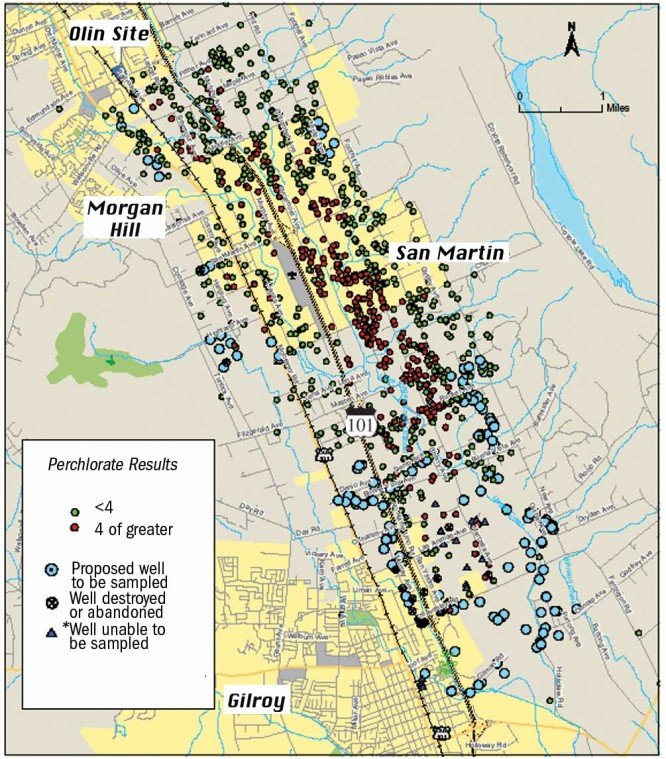SAN MARTIN
– The company that plagued the Morgan Hill, San Martin and
Gilroy groundwater basin with perchlorate is proposing to test
another 161 wells in the tri-town area for the dangerous chemical,
indicating the eight-mile plume continues to move south.
SAN MARTIN – The company that plagued the Morgan Hill, San Martin and Gilroy groundwater basin with perchlorate is proposing to test another 161 wells in the tri-town area for the dangerous chemical, indicating the eight-mile plume continues to move south.
A large portion of the wells to be tested are in south San Martin stretching down to northeast Gilroy, some as far south as Murray Avenue and Sixth Street. However, residents north of the Railroad and Tennant avenue site still await well testing by Olin Corporation – the company that contaminated the groundwater after years of manufacturing road flares at a now defunct factory in Morgan Hill. Olin says it’s not responsible for contamination north of its site.
Although Gilroy wells recently tested positive for the chemical believed to cause thyroid problems and other health issues, officials are not saying the expanded testing program means the perchlorate plume has reached or will continue to move through Garlic Town.
“All it tells us is that sampling done to this point hasn’t identified all the wells that may be contaminated,” said Harvey Packard, a senior groundwater resources engineer with the Regional Water Quality Control Board. “It’s not known for sure if the plume is still moving.”
The new tests will be done in conjunction with regular monitoring of 42 already-tested wells within the stretch between Tennant Avenue and Leavesley Road. Olin Corporation will need to get permission from all well owners before testing or monitoring the water sources.
News of Olin Corporation’s testing and monitoring plans was revealed Thursday morning at the San Martin Perchlorate Community Advisory Group meeting, where residents, area farmers and representatives from the Regional Water Quality Control Board and Santa Clara Valley Water District were on hand.
At the session Thursday, water officials presented an Olin-sponsored study, completed June 30, which examined how the firm will clean up the contaminated site likely by this fall.
Water officials called the study a “thorough” analysis of the complicated aquifer stemming out of the site, but criticized the study for leaving certain critical issues unanswered.
“What’s missing and what was expected is more of a timeline and more definite action plans (for cleaning up off-site contamination),” said Tom Mohr, an engineering geologist for the water district. “It’s fair to say Olin is overwhelmed at the moment. I think what we got was their best shot at meeting the June 30 deadline.
“On the other hand … the number of samples and the location of the samples Olin has tested has gone above and beyond … the minimum required.”
Water district officials met with representatives from Olin Wednesday, however Olin did not send a representative to the advisory session Thursday.
The study, which was conducted by MACTEC Engineering and Consulting, focused on cleaning up the old flare factory site and determining how perchlorate is transported from the site through the aquifer.
“Unfortunately, what we’re looking at is a situation where the train has already left the station,” Mohr said. “Cleaning up the site is important, but the worst of it has already left.”
The study found that from zero to 50 feet below the ground surface at the old flare factory perchlorate levels range from 4 to 18 parts per billion. In another aquifer zone, levels of perchlorate at 98 ppb are found 50 to 200 feet blow the surface. Finally, a third zone deeper than 200 feet below the ground has perchlorate levels mostly around the 4 ppb range.
The leading theory is that perchlorate is localized in the shallowest zone and shifts down into the middle depth as it leaves the site. There it is confined to a “narrow band” around 85 to 100 feet below the ground surface moving south toward Gilroy.
The report states that the perchlorate is not migrating below 140 feet in most areas. However, wells deeper than 140 feet are still vulnerable to contamination since water can flow through screened openings in the wall of a well.
The data regarding the aquifer will be used in the next-step process of determining how to clean up off-site contamination spots, officials said. It was also used in determining which borderline or contaminated wells should be regularly monitored, as well as which untested wells should be sampled next.
The level of perchlorate that triggers state-mandated health risk notices is 4 parts per billion. More than 400 wells from Morgan Hill to Gilroy have already tested positive for between 4 and 100 ppb since testing began in January.
A well owned by Syngenta, a worldwide agribusiness with offices in Gilroy, tested positive for 4.7 ppb in May. The Syngenta site is located at Holsclaw Road south of Gilman in Gilroy. A spokesperson from the company said the contamination would not impact Syngenta products – which include insecticides and seeds – since the Gilroy location is mainly for research and development.
Officials also announced Thursday that Olin Corporation would be taking over delivery of bottled water to residents with poisoned wells starting at the end of July.
Since perchlorate was detected in January, the water district has been delivering bottled water to residents whose wells tested above 4 ppb. Olin will now take over those responsibilities.
“Nothing will change for those who are already getting bottled water,” Mohr said. “The only difference is now the invoices for the water deliveries will go to Olin.”
The water district expects to get reimbursed by Olin at a later date for the costs accrued while it made the deliveries. The exact cost of the water delivery program is not yet available, but the water district says it has spent $1.3 million on perchlorate-related matters since January.
“The bulk of that has been spent on water delivery service and well sampling,” water district spokesperson Mike DiMarco said.
Olin has also agreed to provide water to people whose well water sample contained between 2 and 4 ppb. However, if the well tests below 4 ppb for four consecutive quarters, bottled water service will end July 1 for those receiving water from the water district.
For information on the water delivery program, call 265-2607. The next San Martin Perchlorate Advisory Group meeting will be Aug. 28 from 7 to 9 p.m. at the San Martin Lion’s Club, 12415 Murphy Ave. All future meetings will be scheduled for the fourth Thursday of the month, starting with the August session.












